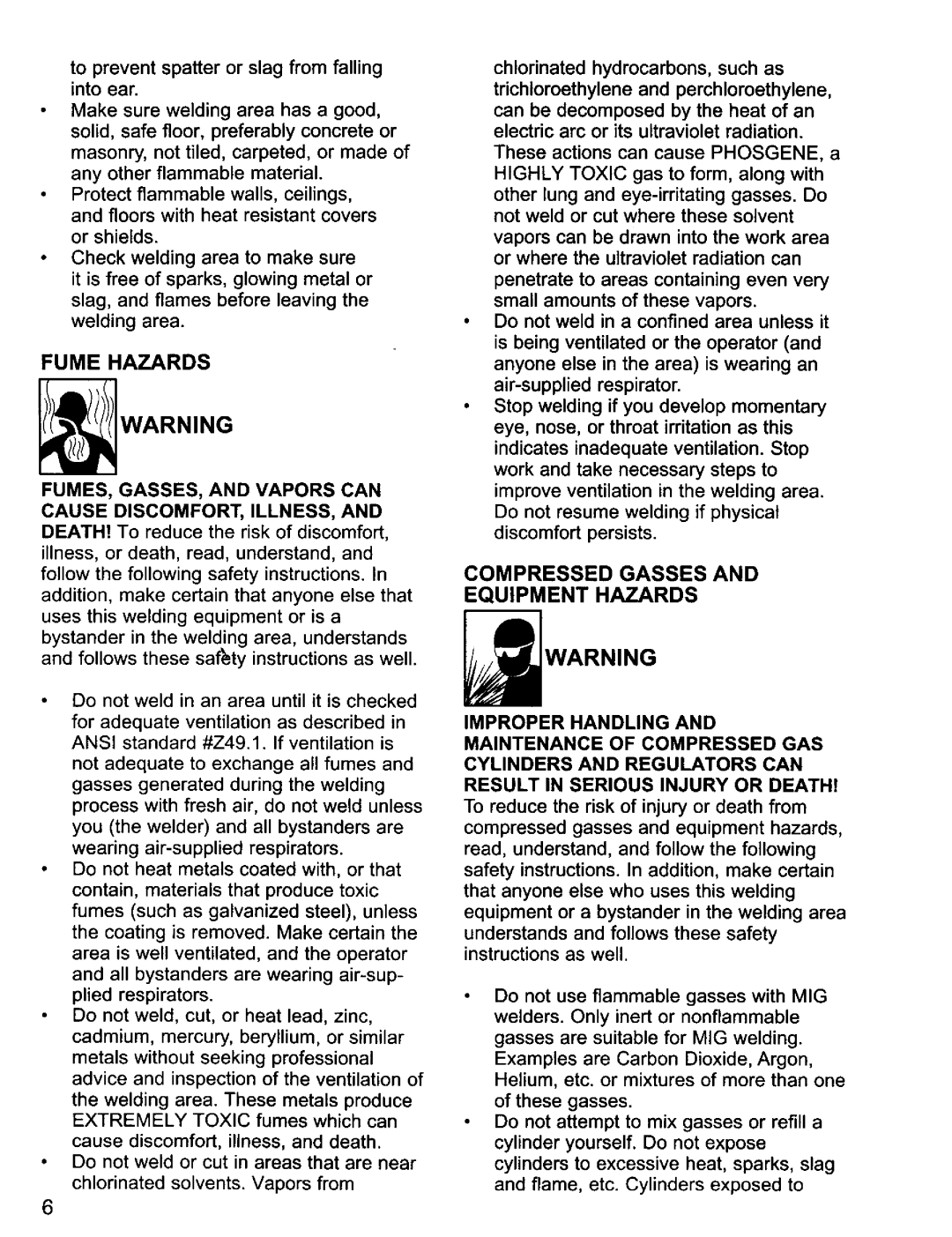
to prevent spatter or slag from falling into ear.
Make sure welding area has a good, solid, safe floor, preferably concrete or masonry, not tiled, carpeted, or made of any other flammable material.
Protect flammable walls, ceilings, and floors with heat resistant covers or shields.
Check welding area to make sure
it is free of sparks, glowing metal or slag, and flames before leaving the welding area.
FUME HAZARDS
WARNING
FUMES, GASSES, AND VAPORS CAN CAUSE DISCOMFORT, ILLNESS, AND DEATH! To reduce the risk of discomfort,
illness, or death, read, understand, and follow the following safety instructions. In addition, make certain that anyone else that uses this welding equipment or is a bystander in the welding area, understands and follows these safety instructions as well.
Do not weld in an area until it is checked for adequate ventilation as described in ANSI standard #Z49.1. If ventilation is not adequate to exchange all fumes and gasses generated during the welding process with fresh air, do not weld unless you (the welder) and all bystanders are wearing
Do not heat metals coated with, or that contain, materials that produce toxic fumes (such as galvanized steel), unless the coating is removed. Make certain the area is well ventilated, and the operator and all bystanders are wearing
Do not weld, cut, or heat lead, zinc, cadmium, mercury, beryllium, or similar metals without seeking professional advice and inspection of the ventilation of the welding area. These metals produce EXTREMELY TOXIC fumes which can cause discomfort, illness, and death.
Do not weld or cut in areas that are near chlorinated solvents. Vapors from
chlorinated hydrocarbons, such as
trichloroethylene and perchloroethylene, can be decomposed by the heat of an electric arc or its ultraviolet radiation.
These actions can cause PHOSGENE, a HIGHLY TOXIC gas to form, along with other lung and
Do not weld in a confined area unless it is being ventilated or the operator (and anyone else in the area) is wearing an
Stop welding if you develop momentary eye, nose, or throat irritation as this indicates inadequate ventilation. Stop work and take necessary steps to improve ventilation in the welding area.
Do not resume welding if physical discomfort persists.
COMPRESSED GASSES AND EQUIPMENT HAZARDS
WARNING
IMPROPER HANDLING AND
MAINTENANCE OF COMPRESSED GAS
CYLINDERS AND REGULATORS CAN RESULT IN SERIOUS INJURY OR DEATH! To reduce the risk of injury or death from compressed gasses and equipment hazards, read, understand, and follow the following safety instructions. In addition, make certain that anyone else who uses this welding equipment or a bystander in the welding area understands and follows these safety instructions as well.
•Do not use flammable gasses with MIG welders. Only inert or nonflammable gasses are suitable for MIG welding. Examples are Carbon Dioxide, Argon, Helium, etc. or mixtures of more than one of these gasses.
•Do not attempt to mix gasses or refill a cylinder yourself. Do not expose cylinders to excessive heat, sparks, slag and flame, etc. Cylinders exposed to
6
